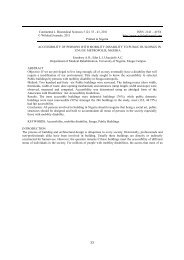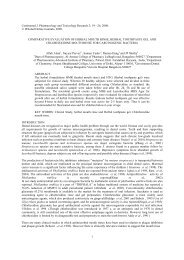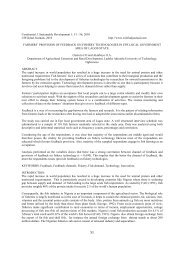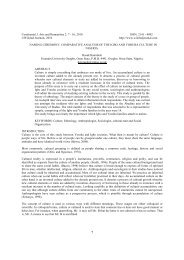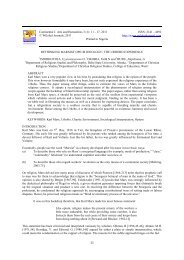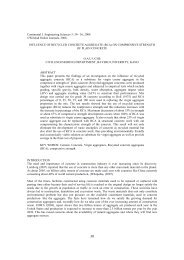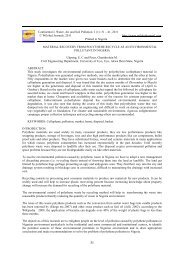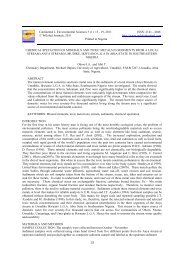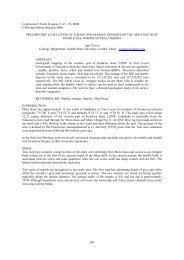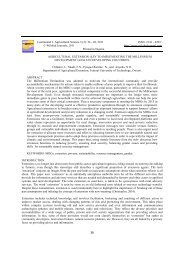Vol 3 - Cont J Pharm Sci - Wilolud Journals
Vol 3 - Cont J Pharm Sci - Wilolud Journals
Vol 3 - Cont J Pharm Sci - Wilolud Journals
Create successful ePaper yourself
Turn your PDF publications into a flip-book with our unique Google optimized e-Paper software.
A. K. Jain et al: <strong>Cont</strong>inental J. <strong>Pharm</strong>aceutical <strong>Sci</strong>ences 3: 1 - 6, 2009<br />
EXPERIMENTAL<br />
Materials and Apparatus<br />
Famotidine was obtained as a gift sample from Intas <strong>Pharm</strong>aceutical, Ahmedabad. Polyvinyl alcohol was obtained<br />
from S.D. Fine Chemicals Ltd. Mumbai. Dichloromethane, ethyl acetate, acetone, acrycoat S100, chitosan were<br />
obtained from Central Drug House (Pvt) Ltd. Delhi. All other chemicals/reagents were used of analytical grade.<br />
Table 1: Different formulations of floating microspheres<br />
S. No. Code<br />
Drug:<br />
ratio<br />
Polymer<br />
Organic solvent system<br />
Polyvinyl<br />
alcohol<br />
(%w/v)<br />
1. C1* 1:1 Dichloromethane: Ethanol 1:1 0.25<br />
2. C2 1:2 Dichloromethane: Ethanol 1:1 0.25<br />
3. C3 1:3 Dichloromethane: Ethanol 1:1 0.25<br />
3. C4* 1:1 Dichloromethane: Ethanol 1.:1 0.5<br />
3. C5* 1:1 Dichloromethane: Ethanol 1:1 1.0<br />
4. A1 1:1 Dichloromethane: Ethanol 1:1 2.0<br />
5. A2 1:2 Dichloromethane: Ethanol 1:1 2.0<br />
6. A3 1:3 Dichloromethane: Ethanol 1:1 2.0<br />
*Formulation coded with different concentration of polyvinyl alcohol (% w/v) using same drug:<br />
polymer ratio<br />
Code<br />
Buoyancy<br />
Table 2: Various formulation parameters for microspheres<br />
Mean Incorporation<br />
Husner’s<br />
size a (%) b<br />
particle efficiency percentage b ratio<br />
Carr’s index Angle of<br />
repose (θ)<br />
C1*<br />
375.1±1.818 86.15±0.044 80.6±2.1 1.66±0.023 14.285±0.345 23.41 ° ±0.035<br />
C2<br />
378.7±2.914 83.15±0.011 79.01±3.3 1.146±0.059 12.79±0.421 22.43 ° ±0.581<br />
C3<br />
389.3±1.984 84.15±0.012 77.56±3.6 1.166±0.039 12.35±0.746 22.15 ° ±0.351<br />
C4*<br />
376.1±1.657 85.52±0.065 81.7±2.1 1.56±0.056 13.13±0.345 22.24 ° ±0.028<br />
C5*<br />
379.1±1.546 84.38±0.038 82.8±2.1 1.42±0.073 13.06±0.254 21.85 ° ±0.026<br />
A1<br />
380.8±2.164 83.15±0.032 76.14±2.1 1.58±0.046 13.58±0.546 22.87 ° ±0.124<br />
A2<br />
383.6±1.854 83.51±0.034 74.85±1.8 1.42±0.028 12.468±0.214 21.85 ° ±0.256<br />
A3<br />
390.6±1.931 81.35±0.016 75.56±1.9 1.35±0.075 11.845±0.587 20.85 ° ±0.428<br />
a Mean±SD, n=10. b Mean±SD, n=3.<br />
Preparation of microspheres<br />
Microspheres were prepared by the solvent evaporation emulsification technique as employed by Struebel et al.<br />
(Struebel et al., 2003). Famotidine as model drug and polymers such as acrycoat S100 (batch A1-A3) or chitosan<br />
(batch C1-C5) was dissolved in a mixture of solvent system at room temperature to be prepare different formulation<br />
systems (Table 1). This dispersed medium was poured into 150 mL 0.1 M acidic solution containing polyvinyl<br />
alcohol as continuous medium at room temperature and subsequently stirred at ranging agitation speed for 2 h to<br />
2






